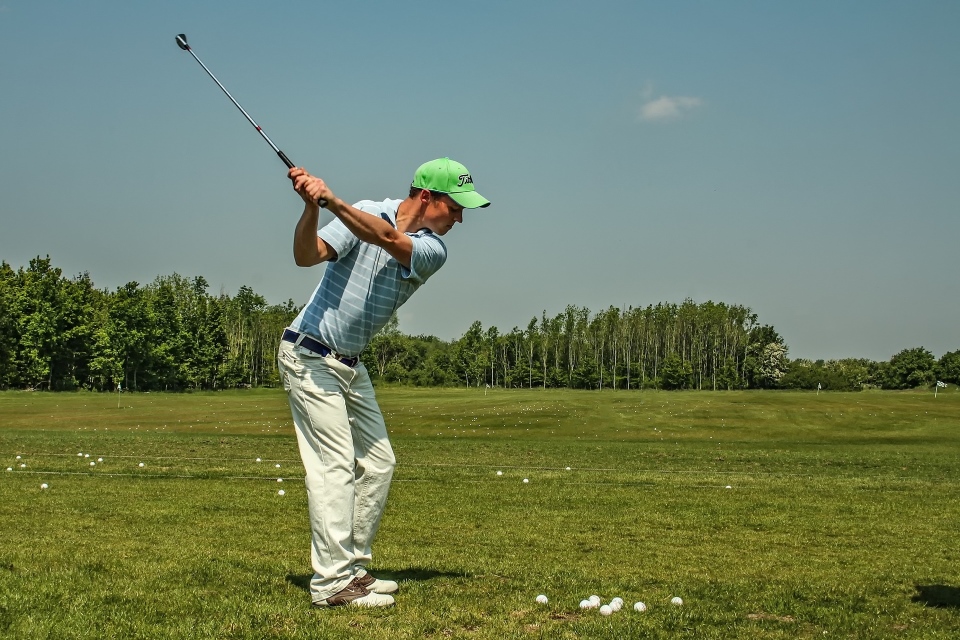Golfstead is reader-supported. When you buy through links on the site, we may earn an affiliate commission at no extra cost to you. Our affiliations include, but are not limited to, the eBay Partner Network and Amazon Associates.

There are many good reasons why you might want to hit the golf ball higher:
- to get over hazards such as water or greenside bunkers
- to get the ball over a tree between you and the target
- to land the ball on the green softly with spin
Being able to bust out the high shot on demand is one of the greatest assets any golfer can have. It also tends to impress the people around you because it suggests you have some skill.
But how do you achieve it? Many people struggle to accomplish anything except a low trajectory with lots of rollout; this is especially true for beginner golfers and higher handicappers.
In this article, we’ll go over six of the best ways to hit the golf ball higher. These tips are generally effective and safe, and the concepts are mostly the same for woods and irons but there are some differences in implementation between the two.
1. Use a higher-lofted club.

The most obvious way to hit the golf ball higher is to use a higher-lofted club.
For example, a 3-wood is going to launch higher than a driver, and a 9-iron is going to launch higher than a 6-iron. The trade-off, of course, it that the higher-lofted clubs will tend not to carry as far.
While this is a reasonably simple concept, it’s also important to look at the specific model of club you’re using. Some woods and irons will have relatively strong (low) lofts, while others will have relatively weak lofts.
The best thing to have in golf clubs in order to hit the ball high is a low center of gravity (CG). Club manufacturers may lower the CG through a variety of means such as adding masses of tungsten within the clubhead.
In addition, shifting the CG towards the back will increase spin which will help the ball go even higher. Manufacturers often achieve this in woods by elongating the club’s footprint.
2. Increase your clubhead speed.

Everything else being equal, it’s a simple truth that the faster you swing, the higher the ball will go. And it makes sense.
Ever notice how many beginners starting out in the game have a low trajectory? It’s mainly because they don’t have the strength and ability to swing fast. At the same time, you have a pro golfer like Jason Day who is well-known for his towering ball flight; he achieves this mainly through having a high clubhead speed.
When your clubhead speed is fast, there’s more energy transfer to the ball. In the case of woods, this results in a higher ball speed and a higher launch. In the case of irons, this helps get the leading edge underneath the ball so it can spin and launch according to the iron’s true loft.
This is why “low spin” and “low launch” clubs are typically marketed to golfers with high swing speeds. Fast swingers often have problems with ballooning shots and are trying to get their trajectory down. Conversely, slower swingers tend to benefit from high-launching clubs.
We cover a multitude of ways to increase your clubhead speed in our dedicated guide here.
3. Shallow out your angle of attack.

If the club comes into the golf ball with a steep angle of attack, it’s natural (and correct) to assume that the ball will tend to fly on a lower trajectory, since the club is imparting more of a downward momentum to the ball at impact.
It then follows that if you come into the ball with a shallower angle of attack that takes less of a divot, the ball will tend to go higher. It will also tend to have less spin which will help increase carry distance.
Shallowing out your golf swing deserves its own article, but here are some tips to keep in mind:
- avoid getting your hands into an excessively high position at the top of the backswing, as this can make it difficult to shallow out the club in the downswing.
- turn your lead arm around your body in the backswing such that the upper part of your trailing arm is roughly parallel to the ground.
- start the downswing with your lower body, not your arms.
- let the butt end of the club point more in front of you instead of straight down.
A great way to get the feeling of shallowing your angle of attack is to get to the top of the backswing and then pretend as if you’re swinging a baseball bat on a more horizontal plane.
4. Shift your weight to your trail side in the backswing.

Not many people mention this, but it’s a simple tip that can make a big difference.
It’s very good practice to load onto your trail side in your backswing, which is the right side for a right-handed golfer. What this does is help you build up energy and promote a proper rotation of the body, which can then be unloaded as you come into the ball.
In the context of hitting the ball high, shifting your weight to your trail side puts you in a position to generate clubhead speed which naturally increases trajectory.
In the case of irons, it also sets you up for a healthy weight shift in the other direction, helping you quickly get the club underneath the ball so it can pop up high into the sky.
A good way to get the feel for shifting your weight onto your trail side in the downswing is to do the following, which has also been demonstrated by pro golfer Jason Day:
- Lay a club on the ground with the shaft pointing directly in front of you.
- Take your normal stance and ball position, and put the right half of your trailing foot on the shaft of the club.
- Hold another club (iron) horizontally across your chest.
- Rotate your body as if you’re making a backswing.
- Feel the weight of your trailing foot pressing on the shaft as you turn.
- Make a full turn such that your head and the club held to your chest are both behind the ball.
If you can get into the position outlined above, chances are you’ve done a good job shifting your weight to your trailing side. The club your foot is on helps steady you so you don’t sway away from the target.
5. Move the ball forward in your stance.

Shifting the ball forward in your stance will tend to make the ball go higher, but there are some caveats to this.
First, when it comes to hitting driver or fairway woods off a tee, you can move the ball forward in your stance more freely. Doing this will help you make contact with the ball on the upswing after you’ve already reached the bottom of your swing arc. This increases the effective loft of the club which results in a higher ball flight.
There is one main downside to doing this, however. Moving the ball too far forward in your stance will encourage you to cut across the ball or even come “over-the-top” in the downswing, resulting in a cut or even a dreaded slice.
Moving the ball farther forward when hitting irons is much trickier because you need to make precise ball-first contact, and it will force you to alter your normal swing in order to make solid contact.
This is why if you want to hit the ball higher, we recommend moving the ball forward in your stance in only very small increments at a time — maybe half an inch to an inch at most. Shift it forward as much as is comfortable for you without needing to make unhealthy compensations in your swing.
6. Use the right shaft.

A lot of golfers don’t give the shaft a second thought when trying to achieve a certain ball flight, but it can make a significant difference.
If you want to hit the ball higher, the first (and probably most important) thing to consider is the kick point. This refers to the area of the shaft that bends the most during the swing, so a high kick point means the shaft bends closer to the grip and a low kick point closer to the clubhead.
Generally, when a shaft has a low kick point, it produces a higher launch and higher spin. Hence, shafts with low kick points are ideal when you want a higher ball flight. The opposite is the case for shafts with a high kick point.
The second thing to consider is the flex of the shaft. A flex that is too stiff for your swing speed is generally going to result in a lower trajectory, so if you want a higher ball flight, adding flex will help.
Be careful not to have too much flex in your shaft, though, as this can introduce a whole bunch of negative side effects. Golf.com has provided a table of the optimal shaft flexes to use for various clubs and swing speeds, which you can check out here.
Conclusion
Hitting the ball higher isn’t necessarily difficult, but it does require a certain command over your golf swing, especially if a high trajectory doesn’t come naturally to you.
You don’t have to implement everything we’ve covered here, but we suggest putting into practice at least two of these strategies for best results.
Pick a few that appeal to you and see if you can get results. Be persistent and patient, and the work you put in should eventually pay off. Then, one day, you may be able to hit those high bombs like Adam Scott or Jason Day.
Thanks for reading this article. Are you struggling with a low trajectory? What are you doing to try to change it? Feel free to drop a comment below.



